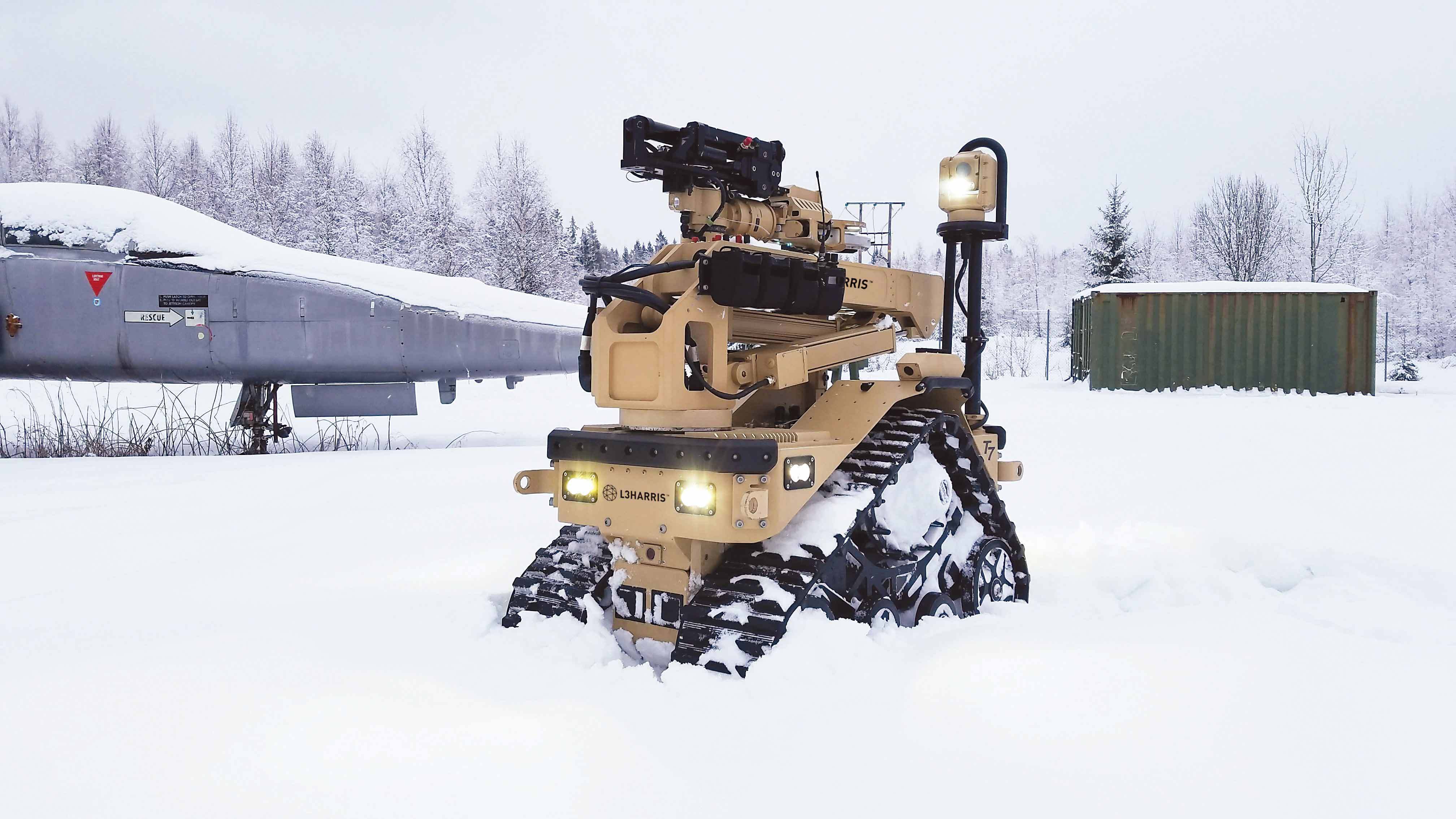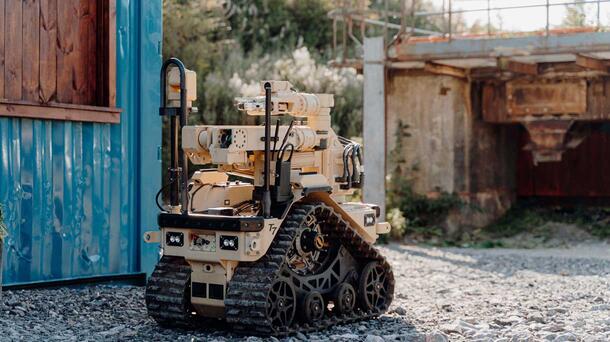If robots in a fleet are inoperative due to maintenance or repairs on a regular basis, this downtime can have an extensive impact on the success of a mission and an expensive impact on the through-life costs of the fleet. Even when a poorly built robot returns from being repaired, it’s only a matter of time until some other part fails or needs replacing and the whole cycle begins again. Moreover, mid-mission failures compound the issue by forcing explosive ordnance disposal (EOD) operators to compensate for the failures and breakages by performing dangerous operations by hand. This isn’t good enough, and all comes down to the same thing: availability.
Overcomplicated or poorly designed robots can break frequently and often have to be shipped straight back to the manufacturer in the event of a failure. As a result, they’re beholden to lengthy repair times that reduce availability and typically an expensive bill that increases through-life costs. However, if a robot is designed well, both in terms of robustness and ease of repair, availability is enhanced and through-life costs are reduced.
That’s why it’s so important to include availability within requirements when going to tender. Greater consideration of availability can make a huge difference in the procurement process, ensuring unwelcomed surprises are avoided further down the line. By including availability in tender scoring criteria, customers gain a stronger sense of how robots will perform on a longer-term basis and the resulting availability and through-life costs versus initial capital investment. L3Harris’ highly available T7™ and T4™ robots enable users to carry out missions with confidence and fleet managers to reduce costs.
Here are four reasons why availability is so important when procuring robotic systems:
1. Ease of Repair
A key obstacle standing in the way of high robot availability is repair time. Given how hard some robots can be worked, especially when customers are in the initial stages of understanding their limits, they can receive a lot of damage. This can be especially true during training – while operators are getting used to a robot’s capabilities, things tend to go wrong more frequently. When this happens, robots that require a complex repair process will often need to get shipped back to the manufacturer for repair, meaning it could be months before the robot returns. Being able to make repairs via local personnel instead saves substantial cost and time.
2. Low availability means high cost
The cost to support poorly designed robots can be significant year-on-year, from buying new parts to replace damaged ones to paying repair personnel for regular fixes. This can even include purchasing more robots than required just to ensure backup units are ready to compensate for any downtime. Moreover, the long repair cycles that come as a result of damages to the robot mean even more cost is squandered – while waiting for the manufacturer to make the repair, all of the money invested in the dormant robot is wasted.
3. The secret cost of spare parts
Another thing to be mindful of when it comes to initial procurement cost is how many spare parts are included with the order and whether that is sufficient to keep the fleet up and running. Robots that break frequently will consume the supplied spare parts rapidly, which not only results in a lot of cost for continuing to replace these parts but can also result in lengthy delays while waiting for the next batch of spare parts to be available. Customers should account for the expense of keeping the robots maintained and running long-term, in addition to any upfront cost. One way to do this is to request a three-year spares pack in the tender and add a penalty clause, which should stop tenderers from underbidding.
4. An inferior experience for operators
A less-available robot can be very limiting for operators; not only do they have to endure an inferior operational experience, but are forced to change how they use the tools available to them. Many will seek alternate ways of achieving what they need to because the required capability is unavailable, meaning a task could take twice as long as it should or a mission isn’t completed properly. What it ultimately comes down to is this: if the robot is not doing the job it is meant to do, it’s not the right robot.

T7™ and T4™: A multi-layered approach to availability
L3Harris values availability and designed the large T7 and medium-sized T4 robotic systems with this in mind. Before T7 and T4 production began, L3Harris prioritized EOD mission requirements, including both operational use and logistical support. The result was robust robot designs and a streamlined repair process, reinforcement against worst case scenarios and weak spot identification and elimination. The systems are constantly refined and enhanced to minimize risk and maximize utility during these dangerous missions.
As such, L3Harris employs a multi-layered approach to availability:
Built not to break
Robust and ruggedized, L3Harris robots are designed to handle demanding military and commercial missions. Every component goes through a rigorous design and selection process to ensure it is able to withstand use in extreme environments. Many of the major components in both T7 and T4 were originally made for high-wear applications such as electric vehicles and off-road automotive systems, so their parts last longer than typical robot components. Offering automotive-grade track systems, military-grade batteries, reinforced chassis and the ability to fire high-power EOD disruptors without damage, they are ready to deliver uncompromised performance.
Repairs as far forward as possible
Robot repairs can be costly and time consuming. L3Harris ensures that the vast majority can be completed easily and inexpensively by the customer in the field. This avoids the need to ship the system back for repairs and saves time and effort.
L3Harris employs four levels of repair:
- Level 1: can be completed by operators mid-mission
- Level 2: can be completed on base
- Level 3: can be completed at the nearest repair facility
- Level 4: has to be shipped back to regional repair and support hub
Most of the time repairs can be done at Level 2 or Level 3, so sending a robot back really is a last resort.
Contingencies Covered
L3Harris robots have contingency options built in to allow for easy fixes in the field. For example, the same type of camera is used across multiple points of the T7 to ensure these can be quickly swapped around to avoid waiting for repairs. That way, the mission can continue in spite of any issues or damages. Both T4 and T7 also provide the ability to remotely debug and reset major subsystems of the robot while it is downrange, enabling fault recovery without the need for manual intervention.
Due to this multi-layered approach to availability, during trials for the UK Ministry of Defence’s (MOD) STARTER program, the T7 exceeded 90% availability goals and even easily surpassed 95%. This calendar year, the T7s deployed in the field by the UK MOD have demonstrated an outstanding 98.7% availability rate. Based on the MOD’s current rate of EOD responses, the robots will likely have responded to more than 2,000 EOD incidents during that time.
T7 and T4 robots were purpose-built with reliability and repairability in mind. This combined with an impressive global footprint and localised support hubs around the world means L3Harris is able to deliver world-class equipment and exceptional in-country support for cutting-edge robotic systems capability anytime, anywhere.
To learn more about these advanced, highly available robotic systems visit here.
